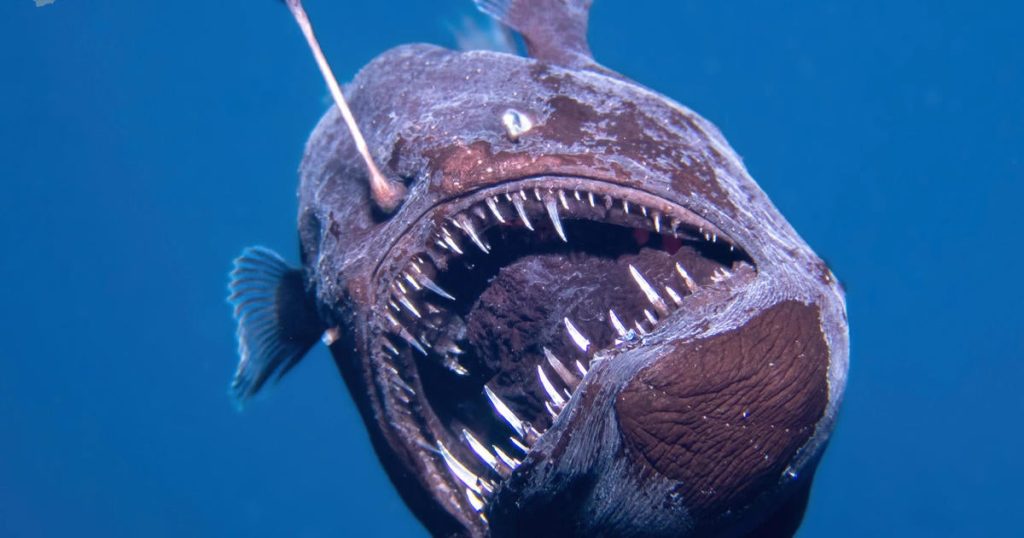A Rare Glimpse into the Abyss: The Black Seadevil Sighting
1. The Historical Sighting of a Deep-Sea Monster
In an extraordinary moment that has left marine biologists and enthusiasts alike in awe, a rare species of anglerfish known as the black seadevil (Melanocetus johnsonii) was spotted swimming near the ocean’s surface in the Canary Islands, Spain. This sighting is believed to be the first-ever recorded observation of an adult black seadevil in broad daylight and at the surface. The footage, captured by marine life photographer David Jara Boguñá and NGO Condrik Tenerife, shows the elusive creature navigating the light-filled waters off the coast of Tenerife. This encounter marks a groundbreaking moment in the study of deep-sea life, as previous recordings of this species have been limited to dead specimens or larvae, with live sightings only possible through the use of deep-sea submarines.
The black seadevil, often referred to as the "black sea monster" due to its scientific name, is a inhabitant of the Bathypelagic Zone, also known as the "midnight zone," where darkness reigns supreme and the only light comes from bioluminescence. Typically found at depths of up to 15,000 feet, this fish is a true predator of the abyss, equipped with adaptations that allow it to thrive in one of the most inhospitable environments on Earth. The unexpected appearance of this creature in shallow waters has sparked curiosity and wonder, leaving researchers with more questions than answers.
2. The Discovery: A Chance Encounter with a Legend
The remarkable discovery was made during a shark research expedition led by Condrik Tenerife, a marine conservation NGO, and photographer David Jara Boguñá. While investigating shark activity approximately 1.2 miles off the coast of Tenerife, the team was surprised to find themselves face-to-face with a creature few humans have ever seen alive. Emerging from the depths, the black seadevil swam into the well-lit surface waters, providing a rare opportunity for observation.
Upon closer inspection, the team identified the fish as a female humpback anglerfish, a specimen remarkably similar to the character depicted in Disney’s "Finding Nemo." The Latin name Melanocetus johnsonii translates to "black sea monster," a fitting description for a creature that has long fascinated scientists and the general public alike. The researchers immediately recognized the significance of their discovery, documenting the encounter in detail and sharing it on social media platforms.
In their Instagram post, Boguñá and Condrik Tenerife described the black seadevil as a "legendary fish that few people will have had the privilege of observing alive." This statement underscores the rarity of such an encounter, which has sent shockwaves of excitement through the marine biology community.
3. The Black Seadevil: A Deep-Sea Enigma
The black seadevil is one of the most mysterious creatures in the ocean, with its habitat and behavior remaining largely unknown to scientists. These anglerfish are found in the Bathypelagic Zone, where the pressure is extreme, and sunlight does not penetrate. Here, they have evolved unique adaptations to survive in the absence of light, relying on bioluminescence to navigate and hunt.
Female black seadevils, like the one documented in the Canary Islands, are equipped with a fishing rod-like structure on their head, complete with a glowing tip that attracts prey in the dark depths. This bioluminescent lure is a hallmark of anglerfish, and its effectiveness is vividly depicted in "Finding Nemo," where a similar species plays a key role in the storyline. The females of this species are also significantly larger and more formidable than their male counterparts, growing up to 7 inches in length, while males typically reach only about an inch.
This size disparity is not unusual in deep-sea anglerfish, where females often dominate as the primary hunters and predators. Their large heads, lined with pointed teeth, are designed for capturing prey in the food-scarce environment of the abyss. The black seadevil’s appearance is as intimidating as its reputation, earning it a place in the imaginations of those who dare to explore the unknown depths of the ocean.
4. TheStar of the Deep: Comparisons to "Finding Nemo"
The black seadevil’s appearance in the Canary Islands has drawn inevitable comparisons to the Disney character known as the "Anglerfish," which captured the hearts of millions in "Finding Neto." While the Disney depiction is somewhat exaggerated for cinematic effect, it does capture the essence of these fascinating creatures. The bioluminescent lure on the anglerfish’s head, used to entice prey in the darkness, is a key feature that both the real-life black seadevil and its animated counterpart share.
However, the real-life encounter in Tenerife offers a rare opportunity to study the genuine article, unfiltered by Hollywood magic. The female black seadevil observed by Boguñá and Condrik Tenerife is a testament to the incredible diversity of life on Earth, even in the most extreme environments. This sighting serves as a reminder of how much remains to be discovered in the unexplored regions of our oceans.
The comparison to "Finding Nemo" also highlights the broader impact of such discoveries on public awareness and education. When rare marine creatures like the black seadevil make headlines, they inspire curiosity and spark a renewed interest in marine conservation. This encounter demonstrates the power of exploration and the importance of protecting our oceans, which remain the last great frontier on our planet.
5. The Mystery of the Black Seadevil’s Surface Appearance
The most intriguing aspect of this sighting is the question of why the black seadevil ventured so far from its usual habitat. Deep-sea creatures like the black seadevil are rarely seen in shallow waters, as they are adapted to the extreme conditions of the abyss. Theories abound among researchers, with possibilities ranging from illness or injury to changes in ocean currents or even the pursuit of prey.
Another possibility is that the fish was displaced by an updraft, a phenomenon in which deep water rises to the surface due to changes in ocean conditions. Alternatively, the black seadevil might have been fleeing from a predator, though this is less likely given the lack of natural predators at such depths. Whatever the reason, the sighting has provided scientists with a unique opportunity to study a creature that has long been shrouded in mystery.
The researchers involved in the discovery described the encounter as "surprising" and one that "did not leave the crew indifferent." Such a reaction underscores the emotional and scientific significance of this moment, which will undoubtedly be remembered as a highlight in the field of marine biology.
6. A New Chapter in Marine Biology: The Significance of the Sighting
The discovery of the black seadevil in the Canary Islands marks a new chapter in the study of deep-sea life, offering insights into the behavior, habitat, and biology of this elusive species. While the encounter was brief, it has already raised important questions about the adaptability and resilience of deep-sea creatures in a rapidly changing ocean environment.
This sighting also serves as a reminder of the importance of marine conservation efforts. Deep-sea ecosystems are among the most vulnerable to climate change, overfishing, and pollution, yet they remain the least understood. By continuing to explore and protect these regions, we can ensure that future generations have the opportunity to study and appreciate the incredible diversity of marine life.
In conclusion, the black seadevil’s appearance in the Canary Islands is more than just a rare sighting—it is a window into the unknown, a reminder of the mysteries that still await us in the depths of the ocean. As we continue to explore and learn, encounters like this one inspire us to protect and preserve the incredible world beneath the waves.















